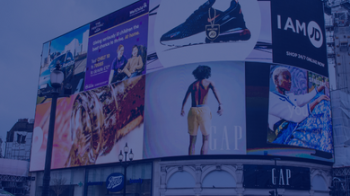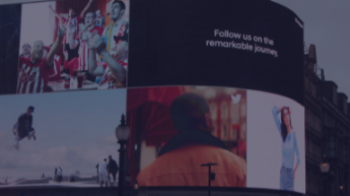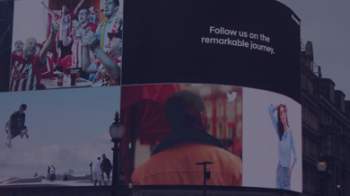What will DOOH in a post-pandemic world look like?
Posted on Friday 03 December 2021 | IAB UK
We brought together members from VIOOH, Kinetic Worldwide and Hivestack to share their thoughts on the future of DOOH in a piece first published by The Drum in November 2021.
There are few advertising sectors that felt the effects of the pandemic quite as starkly as out-of-home (OOH). With lockdowns in place and city centers deserted, the past 18 months have been a huge challenge as advertisers paused spend and technological innovation stalled.
But with vaccines heralding the start of a long process of recovery for our economy, what does this mean for the future of digital out-of-home (DOOH)? The sector is set to grow by almost half in 2021 (43.7%, according to AA/WARC) as footfall returns to high streets and stations alike, along with advertisers’ confidence. So, going forward, how can brands smartly harness technological advances in this space to make an impact via DOOH?
We asked Hivestack’s William Brownsdon, Kinetic Worldwide’s Alys Donnelly and VIOOH’s Helen Miall to share their views.
Innovation in programmatic buying is creating greater opportunities for brands
Helen Miall, CMO, VIOOH: “Prior to 2020, programmatic OOH was growing in popularity, albeit slowly. The unprecedented challenges posed by the pandemic have accelerated the adoption of programmatic techniques and are helping the DOOH industry build back better and stronger.
Brands are now able to take advantage of increased flexibility, data-driven and trigger-based buying and optimization, as well as being able to see in real time the optimal media mix across channels, as programmatic is allowing DOOH to be planned, activated and optimized directly alongside digital elements.
From Nespresso using dynamic creative triggers based on live first-party footfall data, to Renault ZOE using real-time air pollution data gathered via sensors close to digital screens, brands are embracing the opportunities of programmatic DOOH. Even government organizations are onboard, as Tourism Tasmania showed recently, using programmatic’s increased flexibility to manage ad spend by postcode in line with changing lockdown restrictions.
This is why an ever-increasing number of brands are not only testing programmatic DOOH, but are also now moving towards ensuring it is a regular part of their campaign mix.”
By harnessing personalization, brands are seeing results Alys Donnelly, head of programmatic, Kinetic Worldwide: “Brands are now not only taking advantage of the flexibility of bidding in near real-time, but are coupling this with a range of dynamic creative optimization (DCO) options and data triggers to ensure that they are delivering only in the most relevant contexts. Using DCO, brands are now personalizing each creative in the moment. Guiding customers on the street to their local gym or using UV levels to trigger different messaging around sun-care products are just two of the innovative ways that Kinetic clients have used the new features in our programmatic product suite to drive their businesses forward. And these approaches have yielded clear, real-world business results. The sun-care brand saw footfall to stores increase 26% during the campaign. Additionally, a well-known tissue brand saw a 15% increase in brand awareness of its new product range by combining our audience-first targeting technologies with DCO to tailor each creative to the town it was displaying in. These are just a couple of examples of how technology and data are fostering even more creativity in the vibrant OOH space. This sophisticated use of the channel is only set to grow as we move into 2022 - with possibilities on the horizon around cross-channel delivery, audience targeting, and data triggering becoming ever more prevalent and accessible to all.”
By harnessing personalization, brands are seeing results
Alys Donnelly, head of programmatic, Kinetic Worldwide: “Brands are now not only taking advantage of the flexibility of bidding in near real-time, but are coupling this with a range of dynamic creative optimization (DCO) options and data triggers to ensure that they are delivering only in the most relevant contexts.
Using DCO, brands are now personalizing each creative in the moment. Guiding customers on the street to their local gym or using UV levels to trigger different messaging around sun-care products are just two of the innovative ways that Kinetic clients have used the new features in our programmatic product suite to drive their businesses forward. And these approaches have yielded clear, real-world business results. The sun-care brand saw footfall to stores increase 26% during the campaign. Additionally, a well-known tissue brand saw a 15% increase in brand awareness of its new product range by combining our audience-first targeting technologies with DCO to tailor each creative to the town it was displaying in.
These are just a couple of examples of how technology and data are fostering even more creativity in the vibrant OOH space. This sophisticated use of the channel is only set to grow as we move into 2022 - with possibilities on the horizon around cross-channel delivery, audience targeting, and data triggering becoming ever more prevalent and accessible to all.”
The use of data in DOOH is creating more meaningful messages
William Brownsdon, managing director, EMEA, Hivestack: “OOH has always used the power of location targeting to reach relevant audiences with contextual messaging – for instance, shoppers at supermarkets, business travellers in airports and commuters on public transport services. OOH ads have historically been purchased according to predictable consumer behaviour patterns, and are focused on certain spots and geographic locations.
For example, brands have assumed they are likely to reach business travellers at airports during the week, sports fans near stadiums on match days and families in shopping malls at weekends. But while there is always a certain element of routine in daily life and work, habits can be rapidly and irrevocably altered by unpredictable events - from small-scale lifestyle changes to bigger shifts such as a global pandemic.
Programmatic DOOH enables more precise targeting and delivery, allowing brands to reach the right people with the right message and at the right time by activating the most effective DOOH screens in real-time, something that traditional OOH buying does not offer. Targeting parameters can be set around audience movement patterns, geofenced areas, offline behaviour, weather conditions, and proximity to a point of interest. Brands can then define specific audience segments for ad targeting based on their programmatic partner’s data sources, leveraging inputs such as affinity, personas, footfall density and dwell-time.
The availability of thoroughly vetted mobile location data opens up the possibility to deliver creative that is more likely to resonate with the target audience in the moment and drive maximum efficiency for brands.”
Related content
IAB Tech Lab integrates DOOH into OpenRTB
Learn morePutting DOOH in the spotlight
Learn moreHow to succeed in Digital Out-of-Home Advertising
Learn moreDOOH glossary paves way for industry-wide advertising standards
Learn more
Rediscover the joy of digital advertising
Champion connections instead of clicks. Capture audiences' imaginations, not just their attention. Boldly find your own beat instead of letting tech set the pace. It’s time to rediscover the joy of digital.



